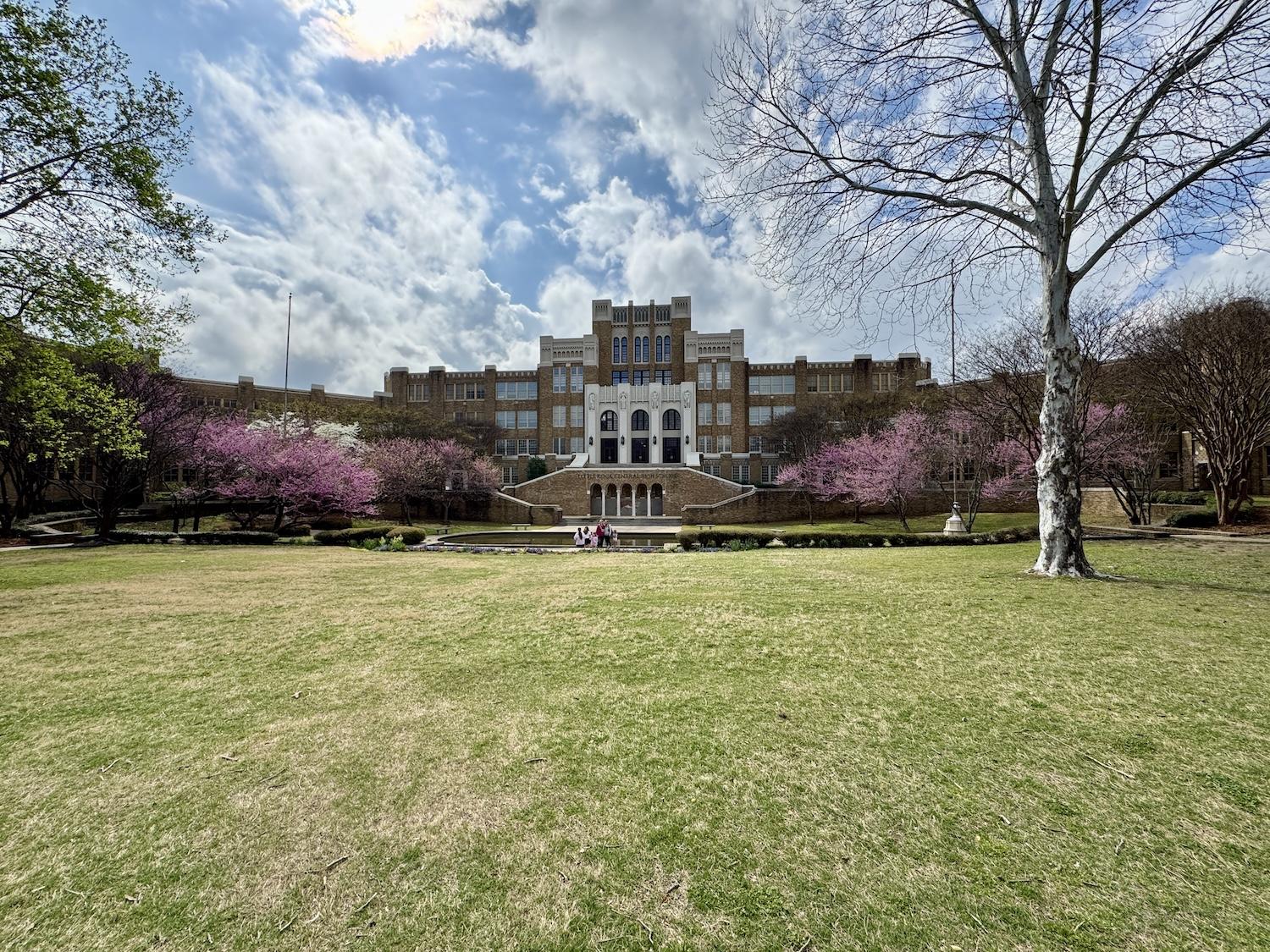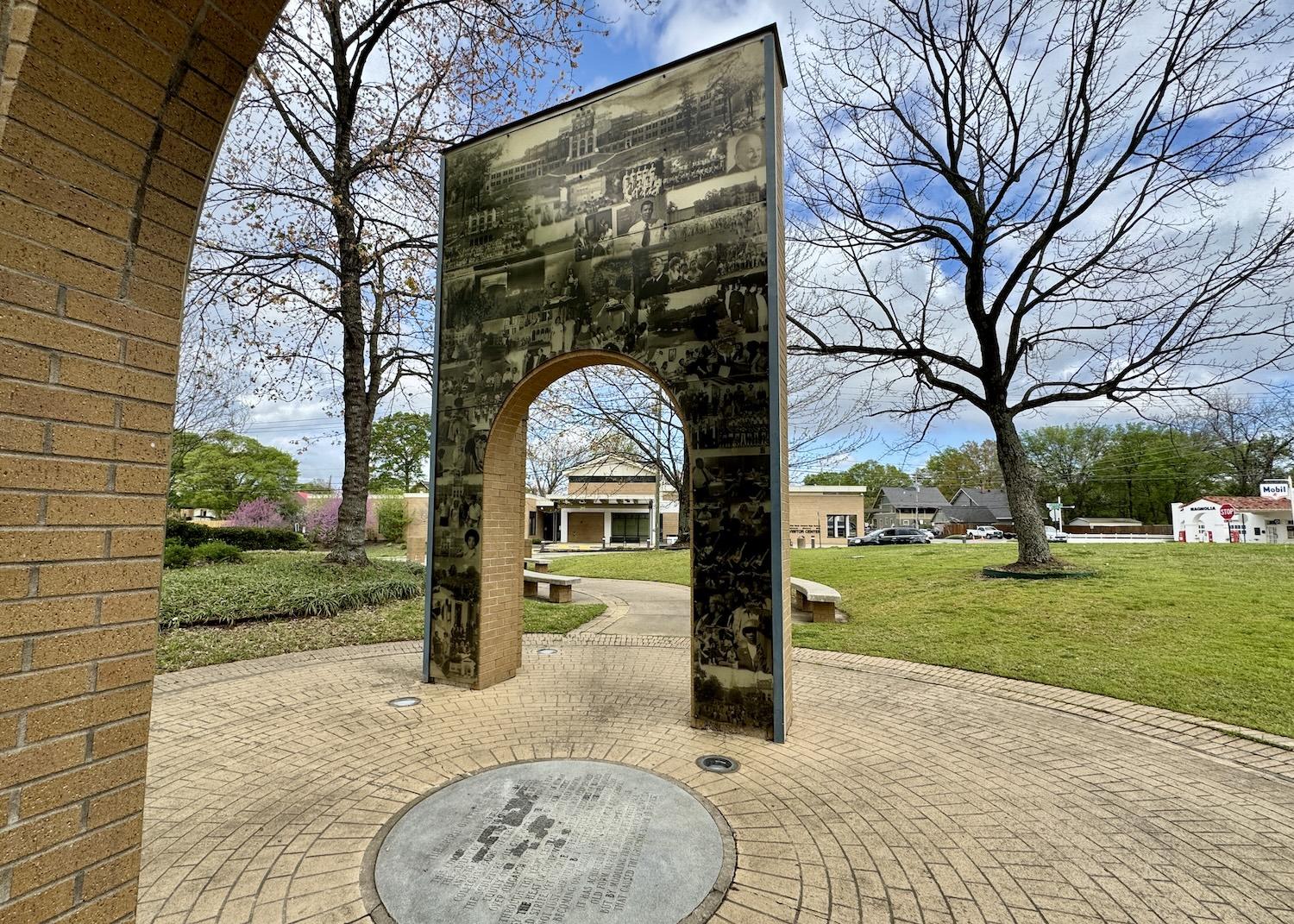It’s appropriately uncomfortable when interpretive park ranger Jazmyn Bernard starts chanting “two, four, six, eight — we don’t want to integrate” on Little Rock Nine Way in front of Little Rock Central High School. Without warning, she transports our tour group back to September 1957 when Elizabeth Eckford was one of nine African American teenagers subjected to racist white mobs resisting desegregation.
“Get outta here. Go to your own school. I’ll kill you if you come to my school. I’ll kill you and your whole family,” the ranger shouts as viciously as she can. “Somebody grab a rope — we’ll hang this little black girl. Lynch her. Lynch her. Lynch her. Two, four, six, eight. We don’t want to integrate. Two, four, six, eight. We don’t want to integrate.”
Bernard’s voice quiets and trembles as she explains that Eckford was just 15 when she walked down this sidewalk alone enduring such venom. She couldn’t enter the school and by the time she fled to a bus stop, she was covered in spit and the special outfit she sewed herself was ruined.
“Elizabeth has said in interviews just last year that she believed if she looked beautiful, if she wore that outfit to school, the kids would be able to see that she was just like them, that they could all be friends,” says Bernard.

NPS interpretive ranger Jazmyn Bernard stands outside Little Rock Central High School showing a 195 photo of Elizabeth Eckford, one of the Little Rock Nine/Jennifer Bain
If you visit Little Rock Central High School National Historic Site and take a ranger-led tour, expect to literally walk in the footsteps of nine teens who battled for civil rights. Besides Eckford, they were Minnijean Brown-Trickey, Ernest Green, Thelma Mothershed Wair, Melba Pattillo Beals, Gloria Ray Karlmark, Terrence Roberts, Jefferson Thomas and Carlotta Walls LaNier. The media dubbed them the Little Rock Nine.
Established in 1998, this National Park Service unit is unique because Little Rock Central is the only operating high school designated as a National Historic Site. That means you can look at it from the sidewalk, maybe even stand by the reflecting pool and climb the front steps, but you can’t go inside since students are usually in class.
Visitors — nearly 64,000 last year — typically start in the visitor center that’s kitty-corner to the school. Then they step outside to see what’s now a minority-majority school plus a historic gas station, replica bus bench and commemorative garden.

Little Rock Central High School is the only operating high school in the United States that has been designated a National Historic Site/Jennifer Bain
“Although Park Street (now Little Rock Nine Way) is quieter today than it was in September 1957, the hostility and prejudice that surfaced then are still a part of our lives today, and still challenge us to stand up and respond to injustice,” an interpretive sign stresses.
It challenges you to consider what you would have done if you were an African American student or parent, white student or parent, or teacher. It asks whether you think equal education is a right. Do the events of 1957 affect our lives today? What would you have been willing to give up? Would you have had the courage to fight for equal rights in 1957? Do you have the courage now?
“If you just don’t say anything, you’re part of the problem and not part of the solution,” Brown-Trickey is quoted on signage as saying. “If all the other teenagers had been like the Little Rock Nine, they could have changed the situation.”

NPS Ranger Jazmyn Bernard stands inside the Little Rock Central High School National Historic Site visitor center/Jennifer Bain
My private group tour would usually include a film, but it's not being shown amid the Trump administration’s attack on DEI (diversity, equity and inclusion).
Instead, we hear how Little Rock Senior (later Central) High School was larger and more expensive than anything else in the U.S. when it opened in 1927. An Art Deco and Gothic Revival-style architectural wonder dubbed “America’s most beautiful high school,” the mammoth school only admitted white students for three decades under “Jim Crow” laws that let educational facilities be “separate but equal.”
The $1.5-million school could hold 3,000 students in 100 classrooms and provided new textbooks, a gymnasium, stadium and quality education. Meanwhile, Paul Laurence Dunbar High School was built nearby for African American students for a fraction of that price with few perks.

An NPS interpretive panel shows historic photos of the Little Rock Nine students studying and trying to go to school/Jennifer Bain
But after the landmark Brown v. Board of Education decision in 1954 held separate educational facilities to be inherently unequal, Little Rock Central became what the NPS calls “the epicenter of a direct challenge to federal authority and enforcement.”
Angry mobs, the Arkansas governor and the Arkansas National Guard blocked two attempts by the Little Rock Nine to enter the school. The students — escorted by the 101st Airborne under orders from President Dwight D. Eisenhower — succeeded the third time.
“I’ve had people come from Japan, Norway and other countries that are like `Yeah we learned about this in high school,’” says Bernard. “So people learn about this history in other places of the world, because the Little Rock Nine changed not only the history within the U.S., but also gave people the encouragement to stand up for their own basic rights within their countries.”

Because it had a payphone and was across from the school that was resisting desegregation, the Magnolia Mobil Gas Station became the de facto media headquarters in September 1957/Jennifer Bain
The rangers leads us outside to the former Magnolia Mobil Gas Station that became the de facto media headquarters during the desegregation crisis because of its payphone and view of the school. Reporters from around the world gathered here in the Arkansas capital and their news reports were among the first to be televised live in the 1950s. You can't go inside.
The Little Rock Nine felt protected by the media presence. As Brown-Trickey has been quoted as saying: “There was so much media coverage, even though we knew [the people in the crowd] were crazy we also knew that they would have to be really crazy to kill one of us in public.”

A photo-filled arch dominates the garden that commemorates the Little Rock Nine. The Little Rock Central High School National Historic Site visitor center is in the background/Jennifer Bain
Even though it's a Saturday in March, people are milling about outside the school and taking photos. It's on this sidewalk that Bernard pretends to be a 1957 protester. Then she takes us to a commemorative bench across from the school that honors the spot where Eckford waited for 35 terrifying minutes for a bus.
We spend some time on the school grounds where a bronze statue called United features two figures with raised arms working to interlock two rings. Artist Clay Enoch “wanted to create something that showed the strides that have been made — something hopeful and uplifting.”
Then I'm on my own for a quick visit to a commemorative garden across from the visitor center with photo-filled arches and nine benches and trees that symbolize the strength of the Little Rock Nine.

Elsewhere in Little Rock, the Daisy and L.C. Bates Home is nationally significant because it was the de facto command post for the Little Rock Nine and their supporters during the desegregation crisis/Jennifer Bain
The visitor center, currently open just five days a week, is closing for the day so I don't have much time to view the indoor exhibits. But I learn that the Little Rock Nine all went on to graduate from college, did interesting things with their lives, and were given Congressional Gold Medals by President Bill Clinton in 1999. Rangers always suggest visits to sites outside of the park boundary — a school, house and the state capitol — that help complete the story.
Named for an African American poet, Paul Laurence Dunbar High School is now Dunbar Magnet Middle School and worth a quick photo stop, if only to see how modest it is compared to Little Rock Central.
Also worth a photo stop is the Daisy and L.C. Bates Home, which is managed by a foundation and can sometimes be toured with advance notice. Daisy, a civil rights activist and publisher, mentored the nine teens and got them to gather at her home at the start and end of each school day so they could travel together. It's 1.6 miles from the school.

The Testament sculptures, on the grounds of the Arkansas State Capitol, commemorate the Little Rock Nine and face the governor's office/Jennifer Bain
On the grounds of the state capitol, be sure to stand behind the Testament statues that represent the Little Rock Nine. They face the Arkansas governor's office as a reminder of what happened in this city and how courageous these trailblazing teens were. Sculptor John Deering “intended for observers to become virtual witnesses, imagining themselves amid the blur of protestors, reporters and troops who surrounded the Little Rock Nine" so he made sure they were spaced out.
As I walk among the statues, I think about how Bernard ended our tour. She said that 200 students tormented the Little Rock Nine, 20 courageously befriended them and more than 1,000 did nothing in the guise of staying neutral.
The ranger urged us to be more than just silent bystanders in life, share the Little Rock Nine story about fighting with love instead of hate, and encourage people to visit this Arkansas site. “It’s a story that any underdog, any person that’s been denied their rights, can look at and say `Oh I connect with it. I am the Little Rock Nine, too.’”



 Support Essential Coverage of Essential Places
Support Essential Coverage of Essential Places






